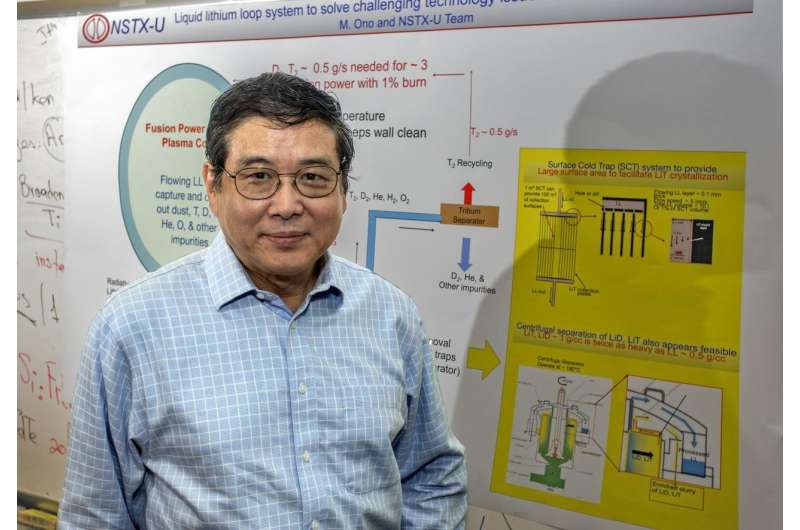Loops of liquid metal can improve future fusion power plants, scientists say

Researchers led by the U.S. Department of Energy's (DOE) Princeton Plasma Physics Laboratory (PPPL) have proposed an innovative design to improve the ability of future fusion power plants to generate safe, clean and abundant energy in a steady state, or constant, manner. The design uses loops of liquid lithium to clean and recycle the tritium, the radioactive hydrogen isotope that fuels fusion reactions, and to protect the divertor plates from intense exhaust heat from the tokamak that contains the reactions.
"There are many challenges to developing fusion energy and the handling of heat on divertor plates is among them," said PPPL physicist Masa Ono, lead author of a paper about the design published in the journal Nuclear Fusion. "We wanted to see how we can protect the divertor plates and keep the fusion chamber clean."
Fusion, the merger of light elements to release energy, is the process that powers the sun and stars. Here on Earth, fusion power plants will combine tritium with its sister isotope deuterium to create the energy for generating electricity. Producing this power in a fusion device is sometimes called "putting a star in a jar."
The system that Ono and colleagues designed calls for pumping liquid lithium in and out of a tokamak, a type of magnetic fusion device, to maintain steady state operation while cleaning out dust and other impurities from the plasma and safeguarding the divertor. The lithium, a silvery metal that readily combines with other elements, would serve a number of functions:
- Covering divertor plates. Injection of liquid lithium into the tokamak divertor chamber would coat the plates with the liquid substance, protecting them from heat and particles that rise up from the core of the plasma. The liquid lithium coating would also act as a sponge, capturing the particles before they struck the plate and preventing them from rebounding back into the plasma to cool it down and reduce fusion performance.
"Even a thin layer of liquid lithium can protect the plates," said Ono. "It also has a promise of improving plasma performance as observed in the National Spherical Torus Experiment and Lithium Torus Experiment at PPPL and in other fusion experiments, and reduces the heat flux. And since liquid lithium evaporates, we must continually provide more to keep the plates moist."
- Recycling tritium, a key fuel that will fuse with deuterium to produce fusion reactions in future power plants. Only approximately one percent of the tritium that is injected into the plasma is expected to be consumed in this process. The remaining unconsumed tritium must be removed and recycled back to maintain fueling.
To accomplish this task, the liquid lithium would combine with tritium in the tokamak and carry it with dust and other impurities to a filter outside the tokamak where the dust would be removed. The next stop would be a cold trap operating at 200 degrees Celsius that would allow the tritium to crystalize out. After draining lithium from the trap, the system would reheat and regenerate the tritium and bring it to a separator that would discard the impurities and pump the tritium back into the tokamak. Alternatively, the loop could feed into a centrifuge that separated the tritium from the lithium and returned the isotope to the tokamak.
Addressing such ideas are PPPL and groups around the world testing flowing liquid lithium concepts. "We are looking to the future to come up with solutions," said Ono. "These issues must be dealt with if we are to realize practical and attractive fusion power plants."
More information: M. Ono et al, Liquid lithium loop system to solve challenging technology issues for fusion power plant, Nuclear Fusion (2017). DOI: 10.1088/1741-4326/aa7f41
Provided by Princeton Plasma Physics Laboratory




















